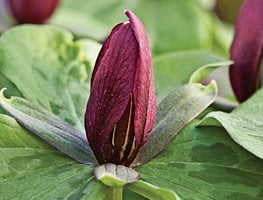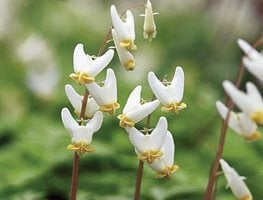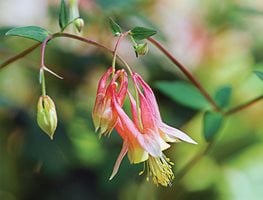9 Spring Wildflowers for Planting in Your Garden
These fleeting beauties are the glory of woodland gardensWhat could be more beguiling — or more intrinsically American — than masses of trout lily, trillium, Dutchman’s breeches and Virginia bluebells carpeting the woodland floor in early spring? Buffeted by chill breezes and braving the risk of late frost, what look like the most fragile of blossoms are actually some of the toughest plants on the planet.
Also called by the quaint names whippoorwill flower, toadshade and wake-robin, Trillium cuneatum is a long-lived member of the lily family, with its parts in threes (petals, sepals, leaves). The deep-maroon flowers rest atop foliage mottled dark green and gray-green, and are sweetly scented. Other trillium species have faintly foul aromas, all targeted to insects like gnats, which are the pollinators. Zones 5 to 9.
BLOODROOT
The white-petaled blossoms of Sanguinaria canadensis pop above the leaf litter and unfurl early, a supportive leaf wrapped around each delicate stem like a shawl. Once the flowers are finished, the gray-green leaves overtop them to shield the developing seedpods. When cut, the gnarly rhizomes exude a red juice, used by Native Americans for face paint and medicinal purposes. Zones 3 to 8.
TROUT LILY
Also called fawn lily and dog-tooth violet, Erythronium americanum forms low-growing colonies of brown-speckled foliage topped by yellow flowers with recurved petals. Emerging from underground corms, plants with twin leaves will flower; those with single leaves are sterile, though they should flower in subsequent years. A similar species, E. albidum has white flowers. Zones 3 to 9.
SHOOTING STAR
A relative of cyclamen with the same swept-back petals, Dodecatheon meadia occurs across the eastern half of the U.S. — from New York to Texas — in glades, wooded slopes and prairies. The 1-foot flower stalks emerge from ground-hugging rosettes of oblong leaves. Typically the blooms are white in the Southeast and pinkish in the western parts of its range. Zones 4 to 8.
DUTCHMAN'S BREECHES
Perched like laundry on a line, the quirky flowers of Dicentra ucullaria dangle from arching stems above mounds of blue-green ferny foliage. Just below ground, this ephemeral’s small fistlike clusters of pinkish bulblets will break apart and reproduce to form large colonies in woodlands from Nova Scotia to Kansas. Zones 3 to 8.
Longer blooming than many spring wildflowers, Aquilegia canadensis can flower into July, after which it dies back to a thick underground stem. Naturally occurring in a range of habitats — from gravelly slopes to rich deciduous forests across the eastern half of North America — columbine’s long-spurred, pendulous red and yellow flowers make it a good hummingbird plant. Zones 3 to 9.
CELANDINE POPPY
A prolifically blooming wildflower native to much of the Southeast and Midwest, Stylophorum diphyllum is a poppy relative, with 3-inch, crepe-paper-textured flowers and distinctively lobed blue-green foliage. Hairy-looking pods can drop a multitude of seeds, which are carried off and “planted” by ants, which relish a fatty appendage on the seeds called an elaiosome. Zones 4 to 8.
VIRGINIA BLUEBELLS
With bright-pink buds morphing into sky-blue tubular flowers dangling from 1- to 2-foot stems, Mertensia virginica is one of the showiest spring ephemerals. Often found along moist stream banks and wooded floodplains, Virginia bluebells can also occur on loamy upland sites. Though the plants have a substantial look, the show is brief, emerging in March and vanishing in May. Zones 3 to 8.
A diminutive member of the iris family, only 4 to 6 inches tall, Iris cristata forms mats of slender interlocking rhizomes on the soil surface, often in limestone-rich habitats. As with many irises, this one requires good drainage. Dainty lavender flowers with a yellow beard emerge in April and last into May. Zones 4 to 8.
Emerging before deciduous trees have leafed out to block the sun and claim every drop of rain that falls, these spring lovelies waste no time producing foliage, flowers and seeds. Some of them, categorized as spring ephemerals, complete their life cycles by the end of May. Once the frenzy is past, forest wildflowers hunker down into dormancy, withdrawing into corms, rhizomes and tubers until they do it all again the next year. Dozing just under the soil surface with plenty of nutrients and moisture in storage, they are unfazed by the heat and drought of summer. Despite the brevity of their display, their low maintenance, longevity and profuse-blooming ways should make them ideal garden plants. But while most will readily spread if left to their own devices, difficulties in intentionally propagating many of them (trilliums can take up to seven years to go from seedling to blooming size) have led to collection from the wild, which can decimate indigenous populations. However, in recent years a handful of determined growers have focused on nursery propagation techniques, and now many spring natives are more readily available from trustworthy sources.
NATURE, NURTURE
CARE: Plant spring-blooming wildflowers in early spring or late summer; established colonies can be divided in early summer as the foliage starts to die down. Mulch annually in late fall or winter with 2 to 4 inches of compost before plants emerge. Mark or map where the plantings are so they aren’t disturbed during later installations of annuals and perennials. To propagate from seed, many spring natives require a series of conditions, including a moist-cold treatment called stratification. Sow seeds in pots when they’re ripe, set the pots in a safe place outdoors (where they will receive rainfall and experience temperature fluctuations but won’t be disturbed by animals) and remember that patience is a virtue. If all goes well, look for seedlings the following spring.
ZONES: The wildflowers shown here are typical of the eastern half of the United States and parts of Canada. Some native woodland species occur as far south as Zone 9 and some as far north as Zone 2.
EXPOSURE: Spring-blooming natives found in the understory of deciduous forests require early-spring sunlight filtering through leafless trees to grow, bloom and set seed before going dormant by summer, so a garden location that mimics that situation is best.
SOIL: Forest-floor soil is high in organic matter from many years of leaf decay, so any location for woodland wildflowers needs to be similarly rich. In an existing forest locale, the nutrients are probably already present. In a newer shade garden, 4 to 6 inches of compost should be added to the top 4 to 6 inches of soil prior to planting. Soil high in organic material also tends to be moist yet well drained — perfect for these early-flowering natives.
SOURCESCheck reputable local sources, or try ordering online from American Meadows or Eden Brothers.









